Table of Contents
The power of voter persuasion is an incredible tool. It’s how Socrates convinced an entire empire into thinking the way he did (although they weren’t exactly “voters”).
In political campaigns, there are two results that need to be achieved from voter persuasion strategies:
- Persuading potential supporters to support your candidate. (Partisan campaigns)
- Persuading voters to turn up to vote on election day (GOTV).
In this guide, we will take a look at creating a powerful voter persuasion strategy for both objectives.
Let us look at each of these separately.
Step 1 of voter persuasion: Targeting the right people
A successful voter persuasion campaign targets the right people, with the right message, via the right channel. You wouldn’t really target a senior citizen through social media promising better education, right? That won’t work with them.
The idea behind targeting is to focus your resources on:
- Those voters who are most likely to vote for you
- Those voters who are most likely to turn up to vote
Targeting is important for two reasons. One, it’ll help you conserve precious campaign resources and get the maximum out of them. Second, it helps you better plan your voter outreach strategies and campaign messaging.
For instance, Let’s say the millennial crowd forms a majority of your target voters.
In that case, your messaging will have to address their issues like better job opportunities, education, etc., rather than pension schemes or childcare.
You’ll also have to reach out to them through the channels they are most active on, like social media or texts.
Let’s assume you’ve already done preliminary research on your voters. That includes collecting information on voter party affiliations, past election performance of similar candidates, persuadability, past voter turnout, etc.
With this data in hand, you can organize all voters in a matrix to weed out those that might not be as important.
Creating a matrix of voters
Here’s how you collate all the information you have on your voters to create an actionable data matrix.
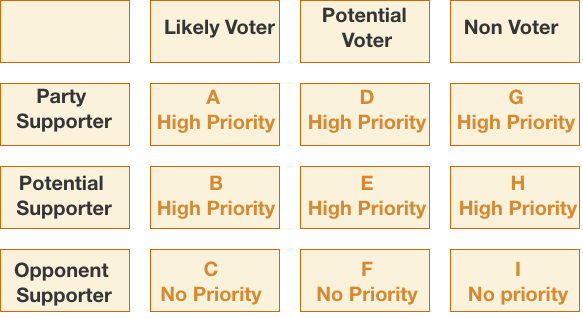
The type of voters (likely, potential, and nonvoter) are decided based on their past voting behavior.
“Likely Voters” have consistently voted in all elections for the past few terms.
“Potential voters” are those who don’t display a consistent pattern but could be encouraged to vote with the right efforts.
“Non-voters” are individuals who have not registered as voters, don’t fall within the voting age bracket, or haven’t voted in the past few terms.
This is one way to classify the voter base.
Another way to segment the voters is based on their party affiliations (supporter, potential, and opponent)
“Party supporters” are those who have voted for your party for at least the past three terms.
“Potential supporters” are those who have not consistently voted for the same party for previous terms. Their affiliation depends more on what is being promised and whether it’s relevant to them.
“Opponent supporters” are the ones who voted for opposition parties for the past three or more terms.

The voters you prioritize will depend upon the above segmentation – their voting behavior and party affiliation.
As is clear from the matrix, Groups A, B, D, E, G, and H are sets of voters that should be your top priority.
Group A – They are your most valuable supporters. You have to solidify your support with them by involving them more closely in your activities.
Engage with them by asking them to help you spread your message in their networks and communities.
Group B – For these voters, you must focus on communicating messages persuading them to support your candidate.
Since they are sure to vote, you just have to make them believe that you’re better than your opponents, and they should be voting for you.
Group D – Individuals in this set might not need as much attention in terms of spreading your party message.
However, you will have to focus on getting them to turn up for the ballot. Ensure that they are made well aware of the fact that their vote counts.
Group E – These individuals have to be engaged consistently throughout your campaign.
First, you must convey that your party is better and will bring the change they want to see. Then, you’ll have to motivate them to come out to vote by letting them know that you won’t be able to do anything without their votes.
Group G – Similar to individuals belonging to group B, these are the supporters you will have to encourage to come out to vote.
People of this group are usually those who feel like their vote doesn’t count or are first time voters who lack knowledge about the process. So when engaging with them, ensure that your message acknowledges both concerns.
Group H – Again, similar to group E, these individuals must be targeted for both kinds of voter persuasion. Individuals falling in this group would be first time voters and those who feel that voting doesn’t matter.
They will also be inclined towards the belief that a political party won’t be able to make a difference in the issues they are facing. That’s another important concern for you to acknowledge.
Groups C, F, & I – These voters don’t need a particular outreach/persuasion strategy.
They are already set on their beliefs and are inclined towards ideologies contrasting yours. And it’s also pretty obvious that your opponent part would already be doing enough to reach out to them.
Now, you can make a secondary matrix highlighting the kind of messaging that needs to be communicated to all these groups.

*Since group A is your strongest supporter, you can pass on your campaign messaging to them to promote it within their networks. Engaging with them in such a way will help you solidify their support for you.
Read Next: How to determine your win number and create a perfect voter outreach plan.
Step 2 of voter persuasion: Developing a powerful message for GOTV and Party Support persuasion
Now that you have your messaging matrix with you, you can start developing appealing campaign messaging that addresses all their concerns.
Highlighting the fact that the messaging a party chooses has a critical role to play in generating the public’s response, President Obama in 2012 stated:

A powerful campaign message is one that fulfills the following important criteria:
It must be relevant to your voters.
Your message must highlight the changes you’ll bring and resonate with the interests and everyday problems of your target voters.
What does it mean for your GOTV efforts?
Voter turnout is usually low because of lack of knowledge and the feeling that an individual’s vote doesn’t make a difference.
A relevant GOTV messaging for voter persuasion would cover the whole voting process in a simplified manner while also highlighting why every vote matters.
What does it mean for your voter persuasion efforts?
Talking about policy changes won’t persuade people to support you, even though that might be what is needed. While targeting different segments of the community, your messaging will have to address issues at the ground level.
For example, you’ll have to talk about provisions for better childcare and education when addressing parents, better jobs when addressing millennials, better pension schemes when communicating with boomers, etc.
It must show a contrast.
Voters have to choose between you and your opponents. Your messaging must showcase how you are different from them.
What does it mean for your GOTV efforts?
While the issues being addressed might be the same, you can show contrast in the way you address them.
For example, while addressing disillusionment among voters, you can highlight facts and figures from past data, use motivating videos, or even strike up one-to-one conversations with them to understand their reasons.
Even when educating first-time voters, instead of basic brochures, send them an instructional video and assign volunteers to help them at every step.
What does it mean for your voter persuasion efforts?
Now even if you are fighting for the same policy changes, you could bend your messaging to acknowledge specific concerns to different target segments.
For instance, let’s say both you and your opponents wish to save the rivers. While your opponent talks about cleaning them, you can talk about reducing industrial dumping in the rivers as a better and long-term strategy.
This is how you can differentiate yourself from your opponent while also highlighting your strengths.
For a more detailed explanation of how to create a political campaign message, you can take a look at this article here: Developing your campaign messaging.
Two important points to remember while developing your campaign messaging:
- Don’t stretch yourself thin by trying to address everyone’s problems. Just focus on acknowledging the issues of the specific target groups shortlisted in the table in the section above.
- Consistently draw the attention of the swing voters by showcasing your strengths and how you are better than the opponents.
Step 3 of voter persuasion: Reaching out to persuade your voters
Now, you have your specific target audience on one hand and a powerful campaign message on the other. So how do you bring both together?
Principle of a voter persuasion strategy
“Repeat your message again and again through different channels”
It’s as simple as that! All winning voter persuasion strategies are solely based on this principle.
A well-organized voter persuasion campaign ensures three crucial elements:
- Campaigners ensure voter contact happens through multiple channels
Voters have a ton of information communicated to them through different channels. Most of this information is often ignored.
Political campaigners have to ensure that they establish voter contact through all or at least a majority of these sources. This helps ensure that the message is clearly delivered to them and they retain it, at least subconsciously.
A multichannel approach also ensures that the supporters are not annoyed by the same information delivered repeatedly, which takes us to the next point.
- Campaigners don’t annoy the voters
Bombarding voters with the same information from the same source will annoy them. It will ultimately lead them to form a negative opinion of you. Furthermore, supporters might also just start ignoring your message.
You can’t just repeat your message; you have to reinforce it. That can only be done by consistently communicating your message through different channels (another reason why a multi-channel strategy is important).
This brings us to the next crucial element.
- Campaigners deliver the same message consistently
In the 2004 Presidential elections, the loss of Senator John Kerry was attributed to the inconsistency of his campaign messaging.
Among his many slogans, some were:
“The courage to do what’s right for America,” which was drawn from his support for the wartime funding bill (that he later opposed);
“Stronger at home, Respected in the world,” which stemmed from his opinion about going to war with Iraq (which, again, he had a mixed stance for);
“The Real Deal” which was only printed on some circular campaign merchandise.
With different slogans and an inconsistent stance on critical issues, he lost the interest of the potential voters who didn’t see the inconsistency as a promising sign of a leader.
An inconsistency in campaign messaging muddles your candidate’s image. It also gives your opponents to highlight this as a weakness and bank on it. This is exactly what George W. Bush did during the 2004 elections.
After locking in these three elements in your plan, let’s take a look at the different channels of communication you can leverage to spread your message.
Communication channels for voter persuasion
In the end, persuading your target voters all comes down to the execution. The final box to tick is how you communicate your message to persuade your target voters.
The following are the most effective channels to convince your voters to support and vote for you.
Community Meetings/Rallies
In small elections, candidates usually meet with the local community to talk about issues that are important to them. Typically, such meetings are hosted at a local community center or public grounds.
In federal elections, candidates conduct events/debates to address large groups of supporters in a region.
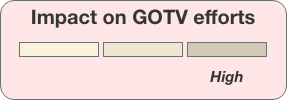
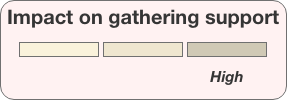
Hearing the campaign message right from the candidate is one of the most effective methods of its delivery.
It helps establish a social connection between a potential supporter and the candidate while giving the voter more insights into the party’s stance.
The 2019 Canadian Federal elections are an excellent example
The Conservatives came close to winning against the long-reigning Liberals. Both these parties had a similar campaign strategy. They aggressively conducted face-to-face campaign rallies in battleground states to grab the swing votes.
It was such a close race because both the competing parties’ campaign strategy was so powerful!
So when you plan to reach out to your electorate, remember to include community meetings and rallies as a prominent method of outreach.
Social Media Campaigns
Seven in ten Americans use social media to engage with news content and share information. Campaigners can leverage paid social media ad campaigns to spread their message.
Alternatively, they can also have their volunteers extensively share their content across their networks organically.


Apart from social proof, social media channels also bring in the peer-to-peer motivation factor. Collectively, both are strong motivators for GOTV and party support efforts.
Watching close friends and family support a particular party is highly likely to inspire swing voters to support the party too. Plus, social media allows you to target the millennials, who usually comprise a major part of the non-voter crowd.
Social media channels allow you to target groups G and H really well.
Door-to-Door Canvassing
Door-to-door canvassing involves approaching your supporters right at their doorstep.
Volunteers knock on doors and engage in meaningful conversations with potential supporters. These usually revolve around addressing concerns they may have and encouraging them to vote for you.


Door-to-door canvassing is rather like face-to-face rallies on steroids. It helps you establish a more personal connection with your supporters. It also works great to gather support for your party by personally addressing people’s concerns and providing insights.
While it’s mostly used to gather support, canvassing also works great for GOTV efforts.
Phone Banking
Phone banking is yet another way of connecting with potential supporters on a one-to-one level. It’s just that these conversations happen on the phone and not in person.
In this, volunteers come together and call voters through phone banking software and persuade them to vote. Typically, they have phone banking scripts that they follow to direct the conversations in a particular direction.
For more insights into how phone banking works for political campaigns, here’s a brief guide on it: What is Phone Banking? It covers everything you need to know – from which dialer to use in your call center software and how to set it up.

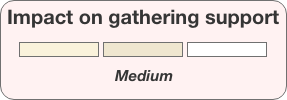
Phone banking is a great way to have one-to-one conversations with people. It’s the next best thing to canvassing. While it is typically leveraged by NGOs to drive GOTV efforts, they could also work well to gain party support.
Phone banking can be used to address the concerns of people falling into groups B and E.
Media Advertisements
Media Advertisements typically comprise radio ads, newspaper ads, and television ads. These types of advertisements allow you to spread your message on a large scale.
In 2018, the average number of newspapers circulated on Sundays was 30.8 million. For the same year, statistics reported that 80% of the US population watched TV regularly, with numbers going up to 90% for Radio. That’s a lot of eyes and ears for your message.


Going by the statistics above, media advertisements do get you a lot of attention. But, they can often get lost amidst the hoard of other information.
Targeting specific segments with your ad can also be quite a challenge. Hence, you will have to get creative to stand out and grab the voter’s attention. This applies to both GOTV and support gathering campaigns.
A good example of getting creative would be the recent ad that was put out by President Donald Trump during the Super Bowl. The Super Bowl attracted 114.4 million viewers this year, and so did the ad.
While the impact is yet to be determined, the clever advertisement highlighting the government’s achievements in the past term got a lot of people talking.
Here’s a link to the ad: https://www.youtube.com/watch?v=E2IV7Z5F7jk
Texting
After direct communication, texting is the next best thing to reach out to voters. Text messaging is typically used to send reminders or updates to supporters compelling them to take some action.


Bulk texting and peer-to-peer texting are the two primary types of texting used for political campaigns. Bulk texting is great for collecting voter information and sending updates and reminders.
Peer-to-peer texting is perfect for encouraging your voters to act (turn up for a rally, donate, or GOTV).
You can also run opt-in campaigns for text messages to grow your supporter base.
Of course, how you use each of these texting options completely depends upon your campaign strategy.
Literature Drop
Literature drops comprise pamphlets or brochures that are distributed either door to door, in public spaces, or during rallies/events.
These pamphlets/brochures can be distributed among potential supporters to spread awareness about the campaign’s messaging and agenda.
Literature drops allow volunteers to cover more ground quickly by dropping off the collaterals and leaving.
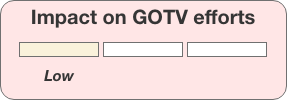
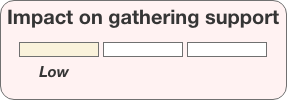
Literature drops are generally used to educate voters about the elections and procedures. Campaigners can also use targeted literature drops to highlight your messaging among potential supporters.
Literature drops are good to be used as a follow-up communication.
Read Next: The Top 5 Key Political Campaign Literature Types And Best Practices
Reaching out to users through email has been an age-old strategy. Campaigners can use emails to complement all other outreach strategies.
For instance, you can highlight details about all upcoming community meets or the positive impact you’ve had in the past through email newsletters.


In recent times, email blindness has been a challenge that campaigners have to overcome during voter persuasion.
However, it is still a great channel of communication. Emails can be used to reinforce your conversations through other channels.
Party Website
A party website will be the base hosting all details of your candidature, messaging, and campaign goal.
An individual’s first instinct is to search for something online after hearing about it. Your website will cater to this instinct and will be crucial in informing potential supporters about you.


Your website, by itself, won’t do much in persuading people to vote or support your party. But, it will be an essential part of all your online communication for voter persuasion. Your website will be primarily used to augment your communications related to persuading voters to support you.
From the above rating of the various channels, it would be extremely tempting to stick to only the high-impact channels for voter persuasion.
That would be a grave mistake.
By completely forgoing a channel of communication, you leave your opponent wide room to gather support via that channel. You also lose out on a solid voter base who frequents that channel.
So, to ensure maximum effect, your voter persuasion strategy needs to implement a mix of all channels.
However, how you prioritize which channel of communication to choose will depend upon the voter matrix. Here is what it would look like:
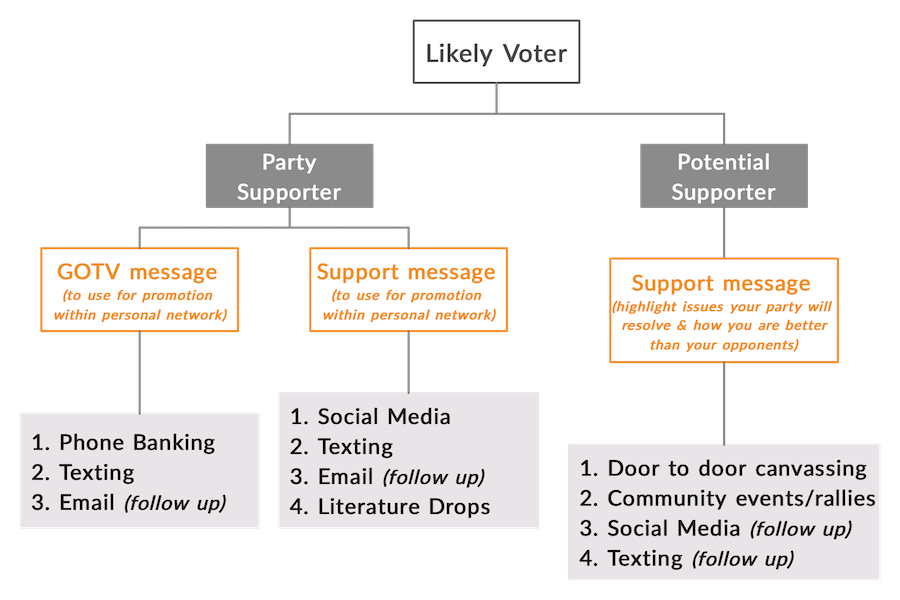
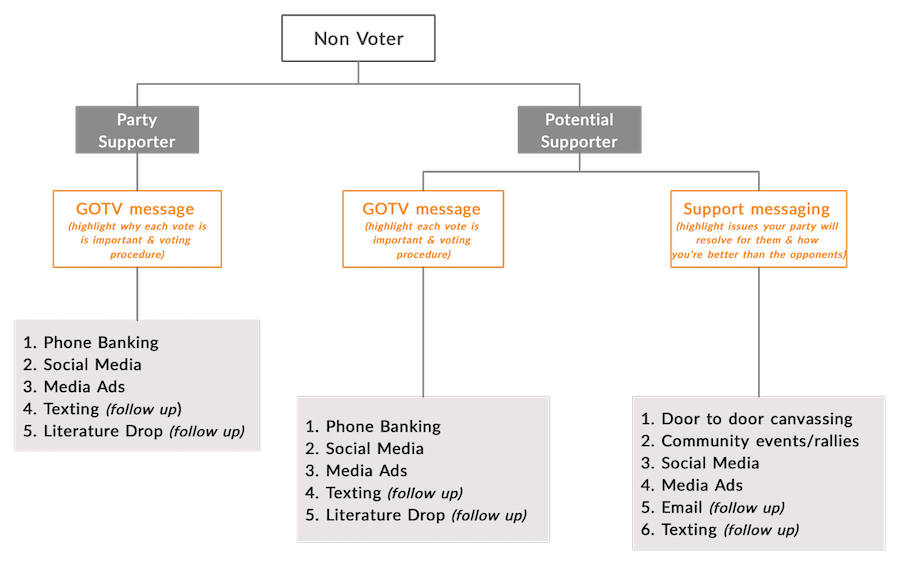
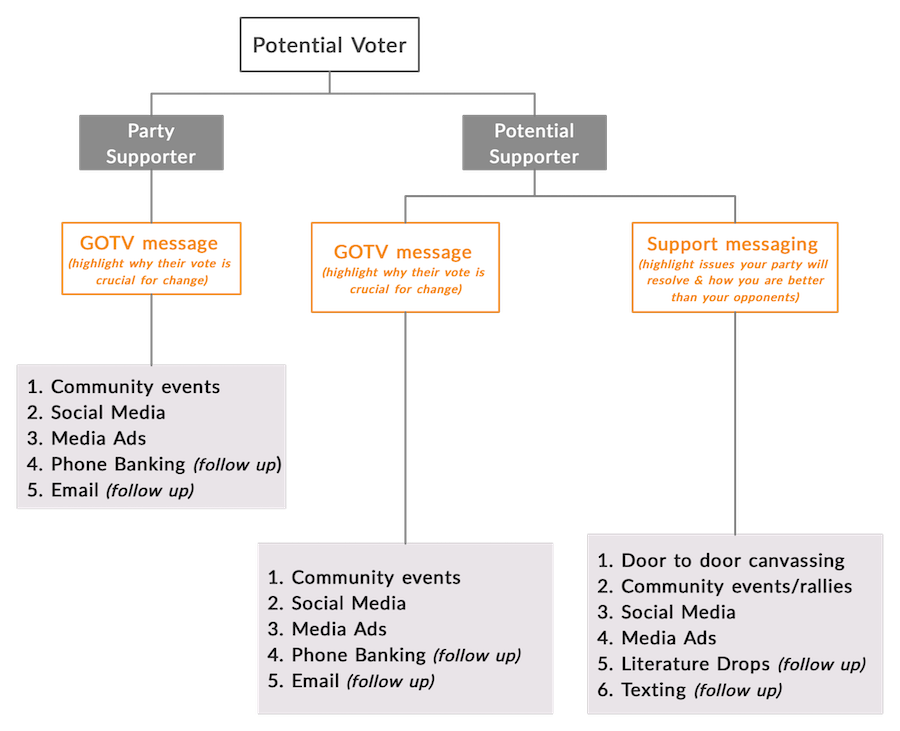
So, are you following all these steps for voter persuasion? Is there anything else you use? Let us know in the comments.

